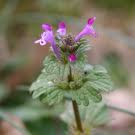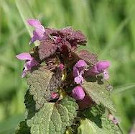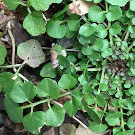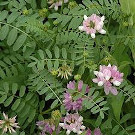12–17 minute read
Routine Care
fertilizing
Fertilize established roses when new growth is approximately 2 inches long. Use the same approach for other plants that you plan to fertilize. The idea is to avoid stimulating growth before reliable warm weather arrives, because new growth is especially sensitive to cold damage. It is safest to use slow-acting fertilizers because they require warm soil to begin working.
mulching
To stimulate plant growth once cold snaps are past, rake mulch away to allow the soil temperature to increase. When plant growth has begun, return mulch to a depth of about 3 inches, keeping it away from plant crowns.
tidying
- Remove leaves from your beds to prevent them from smothering new foliage and rotting plant crowns and bark.
- Remove spent flowers from spring-flowering bulbs, but leave the foliage to replenish the bulb for next year. Don’t braid, tie or otherwise damage the leaves, just let them die down naturally. Plant annuals and perennials like hostas among the bulbs to help disguise unsightly foliage.
watering
Water newly-installed or evergreen plants if weather conditions have been dry
- Choose warm days for watering, because plants cannot take up water if the ground is frozen.
- Water retains heat, so watering just before a cold snap can help plant roots survive bitter temperatures. </li>
houseplants
- Start feeding houseplants again.
- Watch for indoor insect pests. Most can be controlled easily with insecticidal soap.
Special tasks
planting & Propagating
- It is a great time to shop for shrubs and trees, but wait to plant them until the fall.
- You can divide epimediums after they flower. Don’t trim back the new foliage — leaving it facilitates root growth.
pruning
| Jan | Feb | Mar | Apr | May | Jun | Jul | Aug | ||||||||||
|---|---|---|---|---|---|---|---|---|---|---|---|---|---|---|---|---|---|
| TREES | |||||||||||||||||
| shade | |||||||||||||||||
| bleeder | small branches | ||||||||||||||||
| fruit | |||||||||||||||||
| SHRUBS | |||||||||||||||||
| summer-blooming | after bloom | ||||||||||||||||
| spring-blooming | after bloom | ||||||||||||||||
| broadleaf EG | dieback | ||||||||||||||||
| needle EG | |||||||||||||||||
| HERBACEOUS | |||||||||||||||||
| grasses | |||||||||||||||||
| flowers | pinch, deadhead | ||||||||||||||||
If needed, prune spring-flowering shrubs soon after they finish blooming. Because flower buds for next year arise from growth that occurs this year, pruning now avoids sacrificing any flowers. Young shrubs may not require pruning.
soil Test
It is a good idea to test your soil every 2–3 years so that you can adjust pH and fertilize more accurately. Testing is free from April–November. You can pick up and drop off soil boxes, forms, and sampling instructions 8am–5pm M–F in the lobby of the Extension Office: Bonnie B Davis Center, 1020 US-70W.
Learn more about soil testing
problems
disease
Be proactive about fungal disease. The best approach is to purchase genetically resistant cultivars. Otherwise, think of fungicides as vaccines that prevent diseases rather than curing them. Apply fungicide when conditions favor disease development but before symptoms appear.
Minimize dogwood diseases. Keep them watered, maintain soil fertility and clean up leaf litter to reduce disease pressure. When purchasing a flowering dogwood (Cornus florida), seek out disease-resistant cultivars like ‘Cherokee Brave’ (pink bloom, partial resistance), ‘Jean’s Appalachian Snow’ (white bloom, high resistance), or ‘Kay’s Appalachian Mist’ (white bloom, high resistance). Alternatively, plant a Kousa dogwood (complete resistance) or a florida-kousa hybrid from the Rutgers ‘Constellation’ series (moderate resistance).
Monitor azaleas and camellias for leaf galls (white, fleshy growths) and pick them off as they form.
Monitor roses for diseases and insects. If you plan to spray, begin as soon as the first leaves appear.
pests
Beneficial insects share the same plants as insect pests. To protect beneficials, use low-toxicity pesticides when possible, spray only if needed and spray at dusk when pollinators are no longer active. Always read and follow label directions for safe pesticide application.
Click on a pest name in the pest calendar below to learn more.
| Jan | Feb | Mar | Apr | May | Jun | Jul | Aug | Sep | Oct | Nov | Dec |
|---|---|---|---|---|---|---|---|---|---|---|---|
| Emerald ash borer | |||||||||||
| tent caterpillar | |||||||||||
| black vine weevil | |||||||||||
| spider mites | |||||||||||
| scales, slugs | |||||||||||
| aphids, lace bugs | |||||||||||
| bagworm | pick bags | ||||||||||
| boxwood leaf miner | |||||||||||
| ironweed longhorn borer | |||||||||||
| flatid planthopper Japanese beetle CATERPILLARS: genista broom moth silvery checkerspot fall webworm | |||||||||||
| twospotted spider mite kudzu bug | |||||||||||
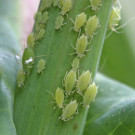 Aphids are usually green but can be many other colors. They attack tender new plant growth. Fortunately, they can be washed off with a forceful stream of water. Severe infestations can be controlled with the relatively environmentally benign insecticidal soaps.
Aphids are usually green but can be many other colors. They attack tender new plant growth. Fortunately, they can be washed off with a forceful stream of water. Severe infestations can be controlled with the relatively environmentally benign insecticidal soaps.
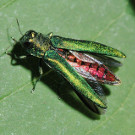 Emerald ash borers have been confirmed in Orange County. They attack all species of native ash as well as our native white fringetree. The top of the crown begins to thin and partially die (sprouting from the main stem of the tree may also occur), followed by death within 2–5 years. While the borers spread a few miles per year by flight, the main route of spread is from contaminated firewood. Interstate movement of EAB-host wood and wood products is prohibited for all of NC. However, movement within our state is not. Please be cautious when purchasing or accepting firewood, wood chips, etc. if you suspect that your trees are infected, please report the location and descriptions of potentially infested trees to 800-206-9333 or newpest@ncagr.gov.
Emerald ash borers have been confirmed in Orange County. They attack all species of native ash as well as our native white fringetree. The top of the crown begins to thin and partially die (sprouting from the main stem of the tree may also occur), followed by death within 2–5 years. While the borers spread a few miles per year by flight, the main route of spread is from contaminated firewood. Interstate movement of EAB-host wood and wood products is prohibited for all of NC. However, movement within our state is not. Please be cautious when purchasing or accepting firewood, wood chips, etc. if you suspect that your trees are infected, please report the location and descriptions of potentially infested trees to 800-206-9333 or newpest@ncagr.gov.
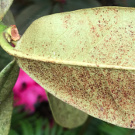 Lace bugs can attack new growth, usually only on azalea/rhododendron, but sometimes on pyracantha, cotoneaster, quince or hawthorne. Dark spots about the size of a pinhead on the lower leaf surface are diagnostic. The best defense is to plant genetically resistant varieties and to maintain plant vigor. For control of severe infestations where there is no evidence that natural predators are present, repeated applications of insecticidal soap or horticultural oil can be effective. When a history of lace bug infestation exists, insecticides can be applied to the lower leaf surface, usually two applications approximately two weeks apart. Monitor the plants about once a month for reinfestations.
Lace bugs can attack new growth, usually only on azalea/rhododendron, but sometimes on pyracantha, cotoneaster, quince or hawthorne. Dark spots about the size of a pinhead on the lower leaf surface are diagnostic. The best defense is to plant genetically resistant varieties and to maintain plant vigor. For control of severe infestations where there is no evidence that natural predators are present, repeated applications of insecticidal soap or horticultural oil can be effective. When a history of lace bug infestation exists, insecticides can be applied to the lower leaf surface, usually two applications approximately two weeks apart. Monitor the plants about once a month for reinfestations.
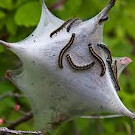 Eastern tent caterpillars often attack young cherries or sourwoods or plants in poor health. Physical removal is an effective strategy — most will be in the tent on a rainy day or at dawn or dusk.
Eastern tent caterpillars often attack young cherries or sourwoods or plants in poor health. Physical removal is an effective strategy — most will be in the tent on a rainy day or at dawn or dusk.
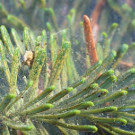 Cool season spider mites can attack many species. Southern red mites prefer broad-leafed evergreens, while spruce mites prefer conifers. They are active in the cooler months, usually during prolonged periods of high humidity. Hold a piece of white paper under a stem and vigorously shake the foliage. Ignore anything that moves quickly. Watch for specks smaller than a period to begin moving. Damage (interior browning of foliage) is not seen until early summer, when the mites are no longer present.
Cool season spider mites can attack many species. Southern red mites prefer broad-leafed evergreens, while spruce mites prefer conifers. They are active in the cooler months, usually during prolonged periods of high humidity. Hold a piece of white paper under a stem and vigorously shake the foliage. Ignore anything that moves quickly. Watch for specks smaller than a period to begin moving. Damage (interior browning of foliage) is not seen until early summer, when the mites are no longer present.
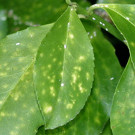 Scales are divided into two groups, armored and soft, based on their coverings. Armored scales usually have several generations a year, can kill woody plants and must be controlled when numerous. Soft scales have a single generation yearly, reduce plant vigor and can lead to unsightly sooty mold, but do not usually kill plants. Often, scale is controlled by beneficial predators. If necessary, try one of the following: 1) Prune out heavily infested shoots/branches 2) On deciduous species, apply horticultural oils or soaps, which will kill all scale stages. 3) Use a registered insecticide to kill crawlers. Monitor for crawlers (tiny, pale yellow specks) by using double-sided sticky tape on several branches.
Scales are divided into two groups, armored and soft, based on their coverings. Armored scales usually have several generations a year, can kill woody plants and must be controlled when numerous. Soft scales have a single generation yearly, reduce plant vigor and can lead to unsightly sooty mold, but do not usually kill plants. Often, scale is controlled by beneficial predators. If necessary, try one of the following: 1) Prune out heavily infested shoots/branches 2) On deciduous species, apply horticultural oils or soaps, which will kill all scale stages. 3) Use a registered insecticide to kill crawlers. Monitor for crawlers (tiny, pale yellow specks) by using double-sided sticky tape on several branches.
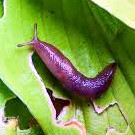 Slugs can attack soft new growth. Holes in leaves or on leaf margins and a silvery slime trail in the morning indicate slug damage. Because slugs hide under boards, stones or debris during the day, populations can be reduced by managing habitat and trapping. Alternative approaches are either ineffective (barriers like diatomaceous earth or copper) or toxic (metaldehyde baits are toxic to pets/children; iron phosphate baits containing EDTA have been found to be toxic to earthworms). To trap, try laying a board near the target plants. Lift at midday and remove the slugs clinging on the bottom.
Slugs can attack soft new growth. Holes in leaves or on leaf margins and a silvery slime trail in the morning indicate slug damage. Because slugs hide under boards, stones or debris during the day, populations can be reduced by managing habitat and trapping. Alternative approaches are either ineffective (barriers like diatomaceous earth or copper) or toxic (metaldehyde baits are toxic to pets/children; iron phosphate baits containing EDTA have been found to be toxic to earthworms). To trap, try laying a board near the target plants. Lift at midday and remove the slugs clinging on the bottom.
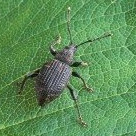 Black vine weevils are destructive to yew, hemlock, rhododendron and several other broad-leaved evergreens. To detect infestation, examine leaves for marginal notches. This cosmetic damage is the result of adults feeding at night and does not endanger the plant. However, the grubs can kill plants by feeding on roots and girdling the lower stems. Treatments targeting adults may be more effective than those for grubs in the landscape setting. See the link for details.
Black vine weevils are destructive to yew, hemlock, rhododendron and several other broad-leaved evergreens. To detect infestation, examine leaves for marginal notches. This cosmetic damage is the result of adults feeding at night and does not endanger the plant. However, the grubs can kill plants by feeding on roots and girdling the lower stems. Treatments targeting adults may be more effective than those for grubs in the landscape setting. See the link for details.
weeds
For common weeds not mentioned below, try this weed gallery. You can check for the toxicity, groundwater risk and persistance of many weed products in Toxicity of Lawn Chemicals.
- Spray wild onion, wild garlic and winter annual weeds with a broadleaf herbicide, following the label directions. Products work best when the air temperature is
50–80° . - Treat perennial weeds such as wild onion and wild garlic with a broadleaf herbicide when temperatures are above 50°. Be careful to distinguish mock strawberry, an invasive alien, from our native barren strawberry.
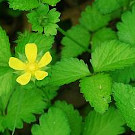 weed mock strawberry
weed mock strawberry wildflower barren strawberry
wildflower barren strawberry - Control invasive vines and unwanted tree saplings.
- For saplings that are too large to pull, cut off close to the ground and clear away debris. Immediately paint or spray the exterior and the cut surface with a 15–25% solution of glyphosate --- waiting more than 5 minutes can prevent absorption. For a larger stump, only the outer two-thirds is live wood and needs treatment.
- English ivy control differs by season. In fall, hand-pull vines and re-visit periodically to remove any residual new growth. In spring, hand-pull or use herbicide.
- Killing or removing weeds before they seed is critical for control. This is especially important for the two new 'superweeds' below. While both are annuals, they are extremely aggressive and produce copious seed, rapidly colonizing your yard if left unattended.



